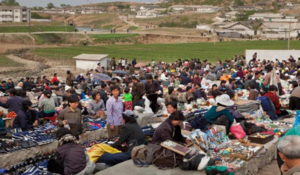Assessment of Pathways to Regime Collapse in the DPRK

Assessment of Pathways to Regime Collapse in the DPRK
Authors | Editors: Kuznar, L. (NSI, Inc.); Pagano, S. (NSI, Inc.)
Introduction and Purpose of Study
The collapse of the North Korean economy and disastrous famine of the mid-1990s forced the regime to adapt its centrally-planned economy—most notably by allowing limited and small-scale private entrepreneurship among a starving population that the government’s Public Distribution System could no longer support. In this context, the North Koreans had turned to informal markets for sustenance in order to survive (Gause, 2018; Park, 2018; Platte, 2018; Rinna, 2018). This “bottom up” marketization resulted in policy reforms that followed rather than led the transition (Haggard & Noland, 2005; Park, 2018; Platte, 2018; Rinna, 2018). While the regime acknowledged the need for these informal markets to meet needs that it could not fulfill, and even instructed state institutions to find profit-making opportunities, the regime nonetheless remained ideologically opposed to marketization and capitalism. The leadership even enacted policy reversals in late 2005 intended to roll back some of this change—including “banning private trade in grain, resuscitating the quantity rationing system, and…rever[ting back] to confiscatory seizures from rural cultivators” (Haggard & Noland, 2005). The regime’s 2007 and 2009 efforts to inhibit private entrepreneurship and decelerate marketization (e.g., through currency reform) were ultimately unsuccessful (Park, 2018).
The informal economy is still in place, represents a substantial sector of the total economy, and has fostered a new stratum of wealthy North Koreans, unattached to the military or traditional elite (Hastings, 2017). The result today is the emergence and continued growth of private entrepreneurs. One estimate is that 20% of the North Korean population is directly or indirectly reliant on “general markets” for survival (DailyNK, 2018). Simultaneously, there are party and military organizations with their own trading companies. This leaves the DPRK with public institutions funded by the state and private corporations liable for paying a percentage of proceeds to the state.
Nonetheless, marketization in the DPRK has remained limited overall. Though Kim Jong Un’s own statements (Kuznar, 2017; Platte, 2018) have highlighted the need for economic development in North Korea, he remains suspicious of further economic liberalization and broad marketization, which he views as a strong threat to the security and survival of his regime (Bennett, 2018; Cheng, 2018; Cronin, 2018; Gause, 2018; Goto, 2018; Park, 2018; Platte, 2018; Sun, 2018). Indeed, observers and scholars continue to question the longer-term implications of these economic developments, and whether there is an insurmountable tension between economic reform and marketization on the one hand, and stability of Kim family political control on the other. This analysis thus addresses the following question: Has marketization put the North Korean regime on a path to near-term collapse?
NSI applied its NSI Pathways™ methodology and model to search for and identify indicators that marketization in North Korea could lead to collapse of the Kim regime.
Comments